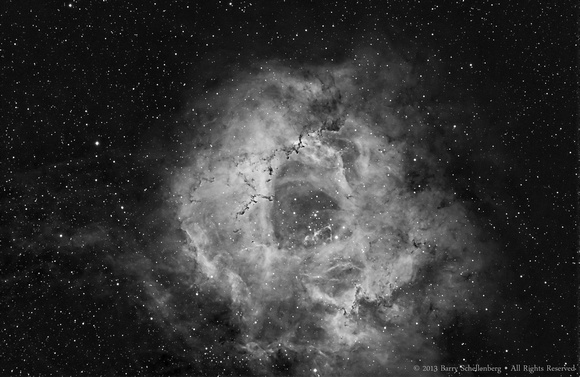Other Names: Rosette Nebula, Caldwell 49, SH2-275
Optics: Borg Astrograph 101ED at f/4.1
Mount: Atlas EQG using The Sky6, EQMOD, & MaxPilote
Camera: QSI 583WS
Filters: Astrodon Ha 3nm
Exposure: 200 Mins, [40 x 300s] Ha
Accessories: Auto guided with Borg 45ED and Orion Starshoot Auto Guider using Maxim DL guiding
Location: Rodeo, NM
Date: November 12th, 2012
Notes: Processing: Image acquisition with Maxim DL Pro using MaxPilote automation. Image calibration, align, and combine in Maxim DL Pro. Levels, curves, crop and resize in Photoshop.
Calibrated w/25 Darks, 93 Bias, 100 Flats using light box,
CCD temperature was -30C. Image was taken near the Arizona Sky Village near Portal, AZ.
High Res Version:
http://astromarina.zenfolio.com/img/s8/v84/p1374414100-6.jpgHaRGB Version: http://astromarina.zenfolio.com/p43889445/h51EB6DCA#h51eb6dcaRGB Version:
http://astromarina.zenfolio.com/p14536770/h51EC196C#h51ec196c The
Rosette Nebula (also known as
Caldwell 49) is a large, circular
H II region located near one end of a giant molecular cloud in the
Monoceros region of the
Milky Way Galaxy. The
open cluster NGC 2244 (Caldwell 50) is closely associated with the nebulosity, the
stars of the cluster having been formed from the nebula's
matter.
The complex has the following
NGC designations:
- NGC 2237 – Part of the nebulous region (Also used to denote whole nebula)
- NGC 2238 – Part of the nebulous region
- NGC 2239 – Part of the nebulous region (Discovered by John Herschel)
- NGC 2244 – The open cluster within the nebula (Discovered by John Flamsteed in 1690)
- NGC 2246 – Part of the nebulous region
The cluster and nebula lie at a distance of some 5,200
light-years from
Earth (although estimates of the distance vary considerably, down to 4,900 light-years.
[3]) and measure roughly 130 light years in diameter. The
radiation from the young stars excite the
atoms in the nebula, causing them to emit radiation themselves producing the emission nebula we see. The
mass of the nebula is estimated to be around 10,000
solar masses.
It is believed that stellar winds from a group of O and B stars are exerting pressure on interstellar clouds to cause compression, followed by star formation in the nebula. This star formation is currently still ongoing.


